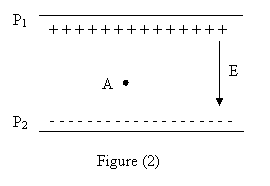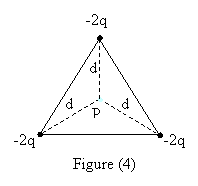KFUPM-Physics102-032
Dr.Aljalal
Sec07
Sec08
Sec09
Recitation ch 23
Answers at the end
Question 1
In figure (2), find the magnitude of the electric field at the
point R: (0,4) mm due to two-point charges q (1 micro-C) and
- q placed at points A: (-3, 0) mm and B: (3, 0) mm,
respectively.

a 9.0*10**6 N/C.
b 4.3*10**8 N/C.
c 3.6*10**8 N/C.
d Zero.
e 7.2*10**8 N/C.
==============================================
Question 2
Which of the following statements are CORRECT:
1. Electric charge is quantized.
2. The potential at the center of a charged conductor is zero.
3. If E = 0 at a point P then V must be zero at P.
4. The electric field inside a charged conductor is zero.
5. If V = 0 at a point P then E must be zero at P.
a 1 and 4.
b 3 and 5.
c 2 and 4.
d 1, 2 and 3.
e 1, 2, and 5.
==============================================
Question 3
Not required for second major
An electric dipole consists of two opposite charges, each
of magnitude 5.0*10**(-19) C, separated by a distance of
1.00*10**(-9) m. The dipole is placed in an electric field
of strength 2.45*10**5 N/C. Calculate the magnitude of the
torque exerted on the dipole when the dipole moment is
perpendicular to the electric field.
a 2.0*10**(-22) N*m.
b - 5.2*10**(-19) N*m.
c - 2.0*10**(-22) N*m.
d 3.5*10**(-22) N*m.
e 1.2*10**(-22) N*m.
==============================================
Question 4
Which one of the following statements is WRONG?
a Electric field lines form a vector field.
b
Electric field lines extend away from negative
charges and toward positive charges.
c The electric dipole consists of two charges having
the same magnitude but opposite sign.
d When an electric dipole is placed in a uniform
external electric field, the net force on it is zero.
e The principle of superposition applies to electric
fields as well as electrostatic forces.
==============================================
Question 5
A particle, of mass m and charge q, is released from rest
at point A in a uniform electric field, see figure (2).
The kinetic energy, due to the electric field, it attains
after moving a distance y is:

a q*E*y**2.
b E*y.
c q*E*y/2.
d q*E*y.
e m*q*E*y.
==============================================
Question 6
A long noncoducting cylinder (radius 12.0 cm) has a charge
of uniform density 5.0 nano-C/m**3 distributed through
its column. Determin the magnitude of the electric field
5.0 cm from the axis of the cylinder. [See figure (3)].

a 34 N/C.
b 4 N/C.
c 31 N/C.
d 14 N/C.
e 22 N/C.
==============================================
Question 7
Not required for second major
An electric dipole is placed perpendicular to a uniform
electric field of magnitude 1*10**5 N/C. How much work
must be applied by an external agent in order to align
the dipole opposite to the field ?
For the dipole : q = 1 micro-Coulomb and d = 2 mm.
a + 0.4 mJ
b + 0.2 mJ
c - 0.1 mJ
d - 0.4 mJ
e + 0.1 mJ
==============================================
Question 8
In figure (4), what is the magnitude of the electric field
at point P, center of the equilateral triangle?
[take d = 2 m, q = 10**(-9) C]

a 9 N/C.
b 22 N/C.
c 18 N/C.
d 11 N/C.
e Zero.
==============================================
Question 9
Not required for second major
An electric dipole has a dipole moment of magnitude
2.0*10**-9 C.m. The dipole is placed in an external
dipole moment initially perpendicular to the field.
The electric field rotates the dipole until it is
aligned parallel to the field.
How much work is done by the electric field ?
a -6.0*10**(-7) J
b +6.0*10**(-7) J
c +12*10**(-7) J
d -12*10**(-7) J
e zero
==============================================
Question 10
Four point charges are placed at the corners of a
square as shown in figure 2.
What is the magnitude of the electric field at the
center of the square ?

a 22.6*k*q/(a**2)
b 1.41*k*q/(a**2)
c 5.66*k*q/(a**2)
d zero
e 2.83*k*q/(a**2)
==============================================
Question 11
Two point charges are located as shown in figure 1.
q1 = +1 micro-Coulomb and q2 = -1 micro-Coulomb.
Find the magnitude of the electric field at point P.

a 4.32*10**6 N/C
b 3.60*10**6 N/C
c 5.76*10**6 N/C
d zero
e 5.04*10**6 N/C
==============================================
Question 12
Which statement is false:
a When an electric dipole is placed in a uniform electric field,
the net force on the dipole is zero.
b The principle of superposition applies to electric fields as
well as to electrostatic forces.
c The electric dipole consists of two charges of the same
magnitude but opposite sign.
d Electric field lines extend away from negative charge and
toward positive charge.
e Electric fields are vector fields.
==============================================
Answers
1 b
2 a
3 e
4 b
5 d
6 d
7 b
8 e
9 b
10 c
11 a
12 d





